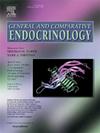Does motilin primarily regulate gastrointestinal motility in fish?
IF 1.7
3区 医学
Q3 ENDOCRINOLOGY & METABOLISM
引用次数: 0
Abstract
Motilin (MLN) is a gut motility-stimulating peptide hormone that regulates the gastric migrating motor complex in humans, dogs, monkeys, and house musk shrews (Suncus). MLN and its receptors are found not only in mammals but also in other vertebrates (birds, reptiles, amphibians, and fish). This review focuses on the physiological roles of MLN in fish. Fish MLNs are produced in the mucosa of the upper small intestine. MLNs in amphibians, reptiles, birds, and mammals are 22-amino-acid peptides with phenylalanine at the first position of the N-terminus, except for reptile MLNs. In contrast, fish MLNs are shorter, and the N-terminal starts with histidine instead of phenylalanine. The function of MLN can be inferred from the distribution of MLN receptors. MLN receptors are commonly expressed in the central nervous system and gastrointestinal (GI) tract of fish, as in mammals. In the central nervous system, MLN is thought to be involved in the regulation of feeding and drinking. However, MLN receptors in the fish GI tract are limited to the intestinal mucosa, and MLN fails to induce contraction in the fish GI tract. In amphibians, birds, and mammals, the expression of MLN receptors extends to GI smooth muscles and enteric neurons and is involved in the regulation of GI motility. These findings suggest that MLN is not a regulator of GI motility in fish, but instead regulates the functions of intestinal mucosal cells and central neurons.
胃动素是否主要调节鱼类的胃肠运动?
胃动素(MLN)是一种刺激肠道运动的肽激素,可调节人类、狗、猴子和麝香鼩(Suncus)的胃迁移运动复合物。MLN及其受体不仅存在于哺乳动物中,也存在于其他脊椎动物(鸟类、爬行动物、两栖动物和鱼类)中。本文就MLN在鱼类中的生理作用作一综述。鱼类的mln产生于小肠上部粘膜。两栖动物、爬行动物、鸟类和哺乳动物的mln是22个氨基酸的肽,在n端第一个位置有苯丙氨酸,爬行动物的mln除外。相比之下,鱼类的mln较短,n端以组氨酸而不是苯丙氨酸开始。从MLN受体的分布可以推断出MLN的功能。与哺乳动物一样,MLN受体通常在鱼类的中枢神经系统和胃肠道中表达。在中枢神经系统中,MLN被认为参与进食和饮水的调节。然而,鱼类胃肠道中的MLN受体仅限于肠粘膜,MLN不能诱导鱼类胃肠道收缩。在两栖动物、鸟类和哺乳动物中,MLN受体的表达延伸到胃肠道平滑肌和肠神经元,并参与胃肠道运动的调节。这些发现表明,MLN并不是调节鱼类胃肠道运动,而是调节肠粘膜细胞和中枢神经元的功能。
本文章由计算机程序翻译,如有差异,请以英文原文为准。
求助全文
约1分钟内获得全文
求助全文
来源期刊

General and comparative endocrinology
医学-内分泌学与代谢
CiteScore
5.60
自引率
7.40%
发文量
120
审稿时长
2 months
期刊介绍:
General and Comparative Endocrinology publishes articles concerned with the many complexities of vertebrate and invertebrate endocrine systems at the sub-molecular, molecular, cellular and organismal levels of analysis.
 求助内容:
求助内容: 应助结果提醒方式:
应助结果提醒方式:


